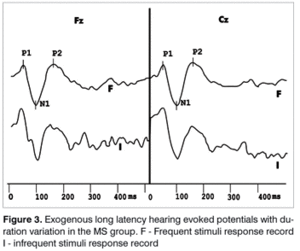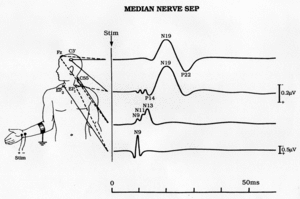Evoked potentials
Introduction[edit | edit source]
An evoked potential is an electrical potential recorded from the nervous system, which is responding to a stimulus and is used for a neurophysiological examination. It can be recorded from the somatosensory cortex or directly through the scalp. These electric potentials in the nervous system are produced by systematic stimulation of a sensory organ or a peripheral nerve, mainly by sight, sound or touch. These stimuli evoke electrical signals that travel along the nerves and through the spinal cord to special areas in the brain. There they lead to potential differences in the cerebral cortex, which can be recorded by placing electrodes on the respected area. Evoked potentials are time-locked to the beginning of stimulation and consist of series of waves characteristic to the stimulus modality. Evoked potentials are mainly used in the neurological field. They help to detect neurological diseases as nerve damages, spinous cord dysfunctions or a demyelinating disease as multiple sclerosis.
Depending of the type of stimulus we can differentiate four main different types of evoked potentials:
Visual evoked potentials (VEP):[edit | edit source]
Visual evoked potentials are used to examine the optical nerves and the visual pathway. Visual stimulation can have various types, for example the flashing light on a monitor. Using VEPs sight disorders can be detected as well than optic nerve damage. A typical disorder detected by VEP is the optic neuritis, an inflammation of the optic nerve, mainly caused by multiple sclerosis. The velocity of the transmission of the impulse to the convertion of the impulse in the brain is measured.
Brainstem auditory evoked potentials (BAEP):[edit | edit source]
Auditory evoked potentials are evoked by acoustic stimuli like a speech sound transmitted by earphones. Brainstem auditory evoked potentials are helpful in the diagnose of a hearing ability and detection of brainstem tumors and multiple sclerosis. Even silent lesions (disease without symptoms) can be detected by BAEPs, although BAEPs are less sensitive and specific than SSEPs. The velocity of the transmission of the impulse is measured in the acoustic system of the brainstem.
Somatosensory evoked potentials (SSEP):[edit | edit source]
SSEPs are providing an evaluation of the central somatosensory pathway and the peripheral sensible nerves. The stimulation occurs transcutaneously, usually by an electric stimulus. The velocity of the transmission of the impulse to the brain or the spinal cord is measured. SSEPs are used for the detection of cervical myelopathy (spinous cord dysfunction). Somatosensory evoked potentials are also used during surgery to examine neurological dysfunction in order to avoid risking brain damage. SSEPs additionally help in the prognosis of the comatose state of patients.
Motor evoked potentials (MEP):[edit | edit source]
For motor evoked potentials no sensory organ is stimulated, but the motor cortex itself either directly or through transcranial magnetic stimulation (TMS). For the TMS procedure a magnetic field generator is placed near the head and via electromagnetic induction the brain receives electric currents. MEPs are mainly used intraoperatively to monitor the intactness of the motor system. MEPs are also used to measure the transmittance between the brain and a muscle at a disorder of cranial nerves or the spinal cord.
Conclusion:[edit | edit source]
Evoked potential studies are considered to be safe procedures. They are objective and very sensitive compared to other neurological examinations and can be also used for comatose or anaesthetised patients. Especially in the diagnose of a developing multiple sclerosis evoked potentials still play a major role. The main disadvantage of evoked potentials is the lack of being disease specific. VEPs can be for example abnormal in optic neuritis as well as in an ocular disease. The use of evoked potentials has been reduced in the last years due to progressive advances in imaging technology, especially magnetic resonance imaging (MRI) and is now often used only complementary.
References[edit | edit source]
• Evans, A.. (2014, March). Clinical utility of evoked potentials. Forsyth Medical Center/Winston. Retrieved from http://emedicine.medscape.com/article/1137451-overview.
• Parkash, P.. (2006). An Introduction to Medical Biophysics. New Dehli, India: Jaypee Brothers Medical Publishers. ISBN 10: 8171795935.
• Splinter, R.. (2010). Handbook of Physics in Medicine and Biology. Boca Raton, Florida: CRC Press, chapter 24-5, ISBN 9781420075243.
• Walsh, P., Kane, N., Butler, S.. (2005, June). The clinical role of evoked potentials in Journal of Neurology, Neurosurgery & Psychiatry. Vol. 76, suppl. 2. ISSN: 1468-330X. Retrieved from http://jnnp.bmj.com/content/76/suppl_2/ii16.full.



